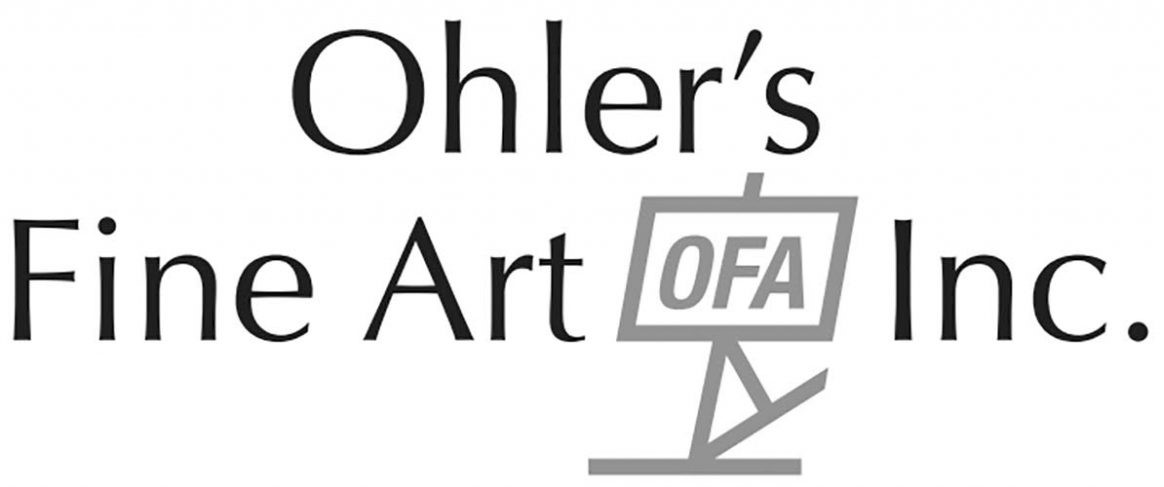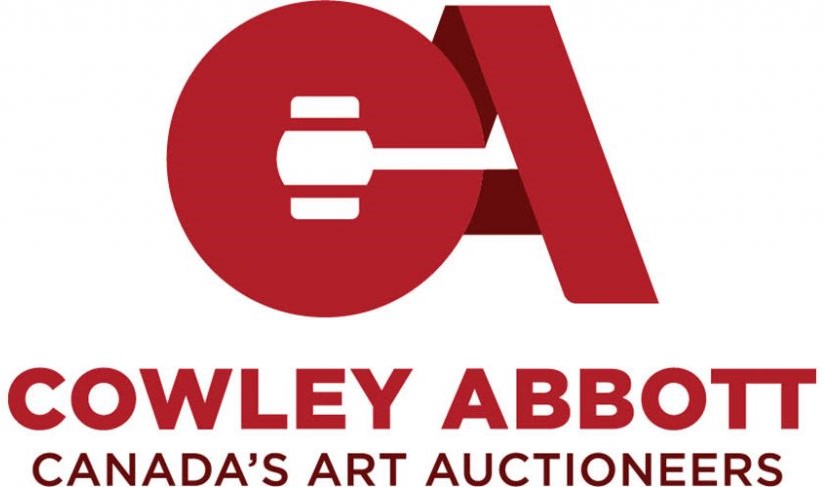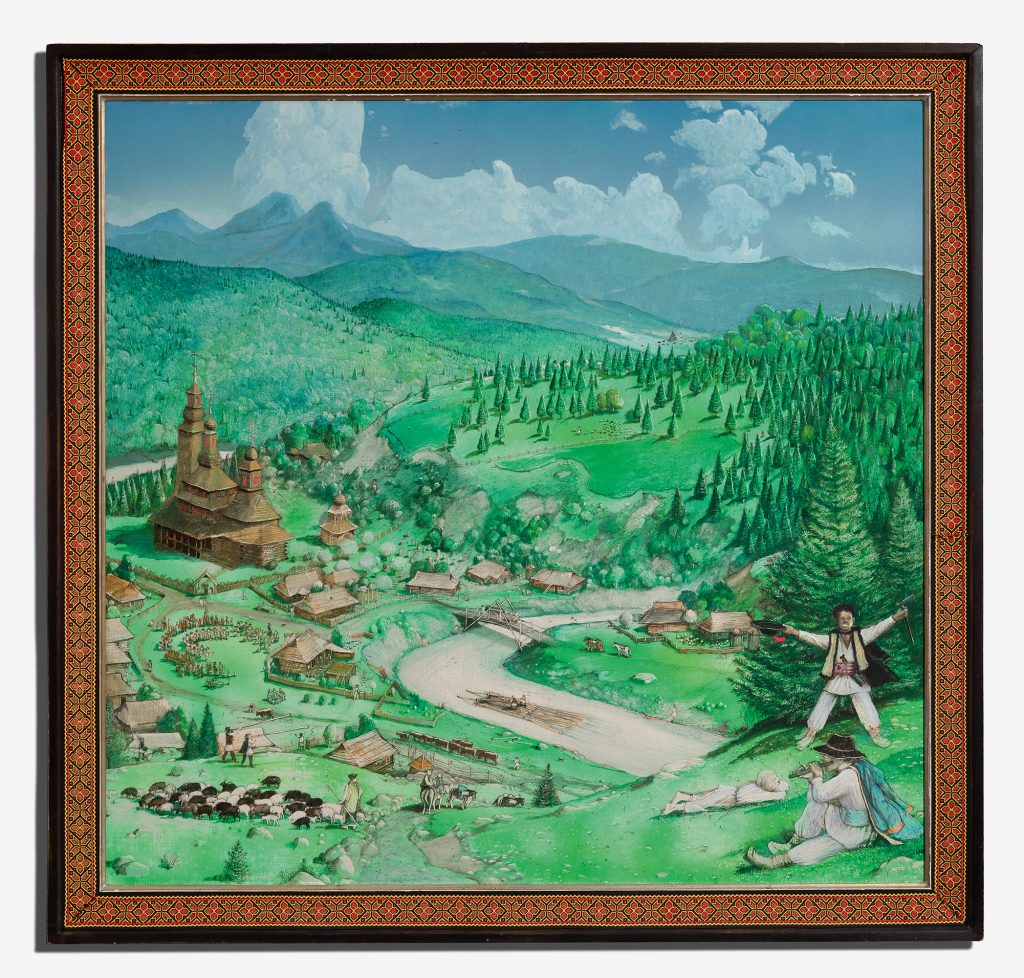Provenance:
Isaacs Gallery, Toronto
Mayberry Fine Art, Winnipeg
Private Collection, Ontario
Exhibited:
“The Burning Barn: 16 Paintings by William Kurelek”, Hart House Art Gallery, University of Toronto, 11-29 March 1969
Literature:
William Kurelek, ‘Development of Ethnic Consciousness in a Canadian Painter’ in Wsevolod Isajiw, “Identities: The Impact of Ethnicity on Canadian Society”, Toronto, 1976, page 47
William Kurelek, “The Burning Barn: 16 Paintings by William Kurelek”, Toronto, 1969
A troupe of venturesome mountaineers at bottom right welcome us into a tranquil world with dance and music. They delight on a slope overlooking a busy bucolic village, nestled next to a meandering river within a verdant valley within what likely represents the mountains and forests of the Carpathian region in western Ukraine. The summer’s hazy cerulean sky vaults the earthly paradise.
Kurelek himself did not actually set foot in Ukraine until 1971, two years after he completed this painting. He was born in Canada in 1927, east of Edmonton, and raised on a farm north of Winnipeg. His parents, relatives, and many of their friends had either arrived on the Prairies from Ukraine over the previous three decades or were the second-generation offspring of immigrants. Seeking greater stability and opportunity, they formed a close-knit community that nurtured the language and customs of their homeland. Kurelek’s devotion to his family’s Ukrainian heritage was also forged in opposition, as a response to the alienation he felt early in life toward the broader Anglo-Canadian culture. And, as a teenager during the Second World War, this patriotism was nurtured by a charismatic priest at his family’s Orthodox church, who “taught us the history of the Ukraine, with its brief moments of glory.” Then, Kurelek “dreamed of doing great things for the cause of Ukrainian liberation,” idealizing “the Ukrainian countryside, people, and culture.”
Kurelek’s love for Ukraine and its people endured throughout his life. But what the artist describes as his “ethnic consciousness” became more nuanced following his conversion to Roman Catholicism in the late 1950s. In his mature art, devotion to “countryside, people, and culture” often shared centre stage with the lessons of his new faith. Indeed, “Free Ukrainian Mountaineers”, one of two versions that exist, is part of what Kurelek described as his “second socio-religious comment series,” entitled “The Burning Barn”. We witness more obvious social and religious commentary in paintings like “Our World Today” (Department of Foreign Affairs, Ottawa) and “Cross Section of Vinnitsia in the Ukraine”, 1939 (Winnipeg Art Gallery), which hung alongside the other version of “Free Ukrainian Mountaineers” (Art Gallery of Hamilton) at the Hart House exhibition (University of Toronto) in March 1969.
“The Burning Barn”, which Kurelek had originally—and curiously— intended to title “Health,” was, in fact, his third exhibition to make explicit reference to societal and religious themes. However, whereas an unremitting sense of gloom predominated his previous efforts— “Experiments in Didactic Art”, 1963 and “Glory to Man in the Highest”, 1966—The Burning Barn struck a balanced tone. Paintings exploring social injustice and global turmoil were matched with those, like “Free Ukrainian Mountaineers”, expressing more positive themes of freedom, joy, and hope. The artist also “endeavoured to offset” criticism that his earlier pessimism did not match his Christian character “by painting most of the happy scenes larger than the unhappy ones.”
While seemingly pastoral and nostalgic, “Free Ukrainian Mountaineers” is also indelibly contemporary, a hopeful reminder amid the Cold War. Today, seeing this work in the context of the current Russian invasion of Ukraine should also remind us of the ways in which the atrocities of totalitarianism were being exposed, and increasingly resisted in that country by the end of the 1960s. Completed at a time when dissident activity was increasing in Eastern Bloc countries and broadening awareness to the true scope of Stalin’s legacy of terror in places like Ukraine, the painting is an exercise in defiant idealism. It offered a beacon of hope, in Kurelek’s mind, for “the new ‘global village’ situation in which man finds himself,” a means to help develop “a measure of new collective conscience about this plight of his less fortunate fellow man abroad.”
We extend our thanks to Andrew Kear, Canadian art historian and Head of Collections, Exhibitions and Programs at Museum London for contributing the preceding essay. Andrew is the past Chief Curator and Curator of Canadian art at the Winnipeg Art Gallery, a Curator of the 2011/2012 national travelling exhibition “William Kurelek: The Messenger” and author of the Art Canada Institute’s “William Kurelek: Life & Work”, available at www.aci-iac.ca.





